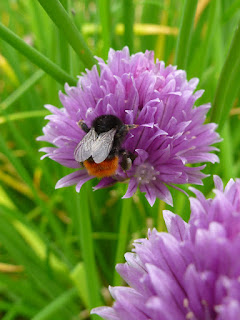Bee Count 2017
The Great British Bee Count 2017 is well underway. Whether or not you have signed up to take part, it's still worthwhile taking note of the different types of bees you see on the allotment.
We all know that our native bees are struggling. This is mainly due to loss of habitat and widespread use of pesticides. Bees, and other insects such as wasps and hoverflies, are almost crucial in enabling us to grow vegetables. It would take a lot of effort to pollinate all our crops by hand if bees were not around to do it for us.
On the allotment and in your gardens at home, you can help bees by providing them with a source of nectar from early spring to late autumn. Grow herbs and edible flowers, plant a few bulbs, treat yourself to fragrant sweet peas or other cut flowers.
It is good to see so many of our plot-holders now grow a row or two of flowers amongst their vegetables: cosmos, gladioli; tulips; daffodils; hollyhocks; delphiniums; marigolds... a treat for the soul as well as a treat for the bees.
Get the children involved by growing sunflowers or create a 'wild' corner and make a simple insect home from a pile of twigs covered with earth.
For more information, bee identification guide, and lots of ways in which you can help bees click here.
Also see blog post 'Bulbs for Bees'.
Photo above - female red-tailed bumblebee
We all know that our native bees are struggling. This is mainly due to loss of habitat and widespread use of pesticides. Bees, and other insects such as wasps and hoverflies, are almost crucial in enabling us to grow vegetables. It would take a lot of effort to pollinate all our crops by hand if bees were not around to do it for us.
On the allotment and in your gardens at home, you can help bees by providing them with a source of nectar from early spring to late autumn. Grow herbs and edible flowers, plant a few bulbs, treat yourself to fragrant sweet peas or other cut flowers.
It is good to see so many of our plot-holders now grow a row or two of flowers amongst their vegetables: cosmos, gladioli; tulips; daffodils; hollyhocks; delphiniums; marigolds... a treat for the soul as well as a treat for the bees.
Get the children involved by growing sunflowers or create a 'wild' corner and make a simple insect home from a pile of twigs covered with earth.
For more information, bee identification guide, and lots of ways in which you can help bees click here.
Also see blog post 'Bulbs for Bees'.
Photo above - female red-tailed bumblebee

Comments
Post a Comment